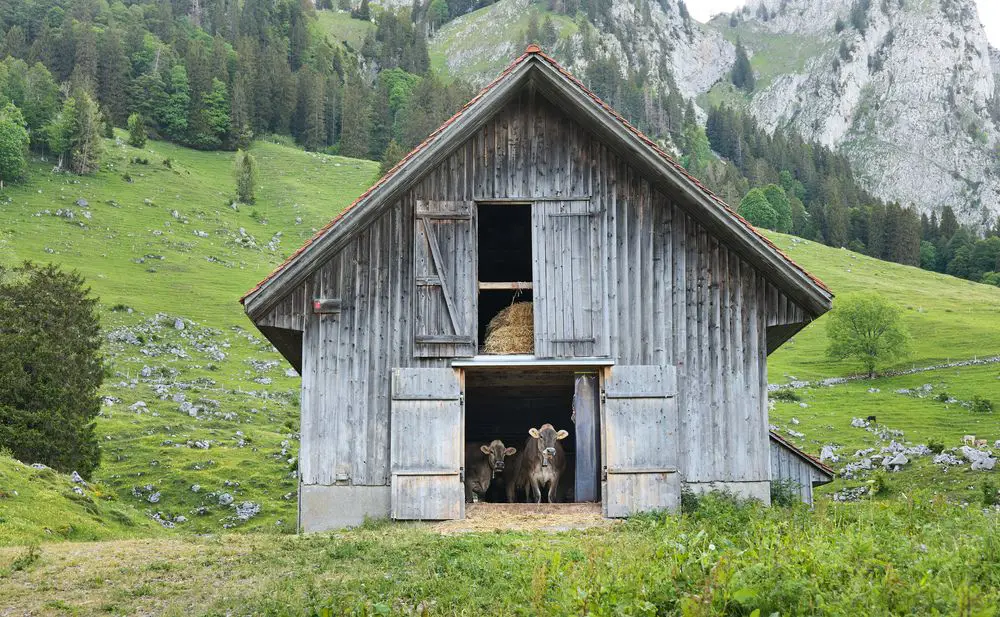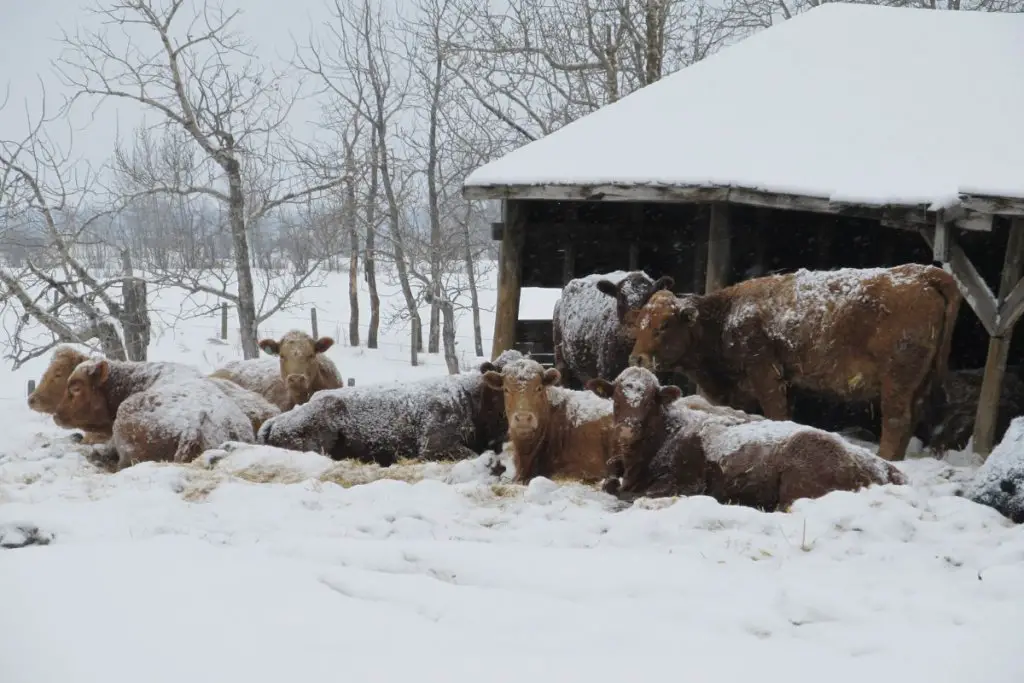You can keep cows happy and healthy through the winter months by providing plenty of fresh water and feed, reliable shelters and bedding. Artificial or natural windbreaks on your property will also help shelter from the wind, while calves can be given special calf jackets if venturing outside.
Warm, healthy, and well-cared-for cows give plenty of high-quality milk. Ruminants are generally pretty hardy, but they are still affected by low temperatures. Avoid raising stress levels in cattle as this leads to a reduction in the quantity and quality of milk production and “dark cutting” in beef cattle.
A dark cutter, also known as DFD (or dark firm dry), is a beef carcass from an animal that has undergone high-stress levels before slaughter. This dark-cutting beef is dark red and somewhat sticky, consequently making the meat appear less appetizing to consumers and fetches a lower price.
Table of Contents
Cows in Cold Temperatures: How They Cope
Cattle start to experience lower comfort levels when the temperature drops to 30 degrees Fahrenheit. Once the apparent temperature drops to below 20 degrees, cows will use their energy and stored body fat to stay warm. Cold winds whipping across the pasture may chap and damage their udder and teats, leading to reduced milk production.
Beef cattle with a good body condition of 5 or above can resist cold stress more efficiently than thinner cows due to their fat reserves acting as insulation against extreme cold.
Combatting Body Mass Loss
A cow with an average body condition score (2.5 to 3) will have its energy demands increase in cold weather by 1% for every degree Fahrenheit the temperature drops below 30 degrees. When temperatures fall below 0, a cow would need approximately 33% more food to maintain body heat than it would at 50 degrees.
Once you introduce rain and wind chill, their nutritional needs increase sharply. Cattle with wet hair coats struggle to produce sufficient body heat to stay warm in winter storms. Shivering uses a tremendous amount of calories, so keep your cattle warm and fed with plenty of nutritious hay before and during storms.
How To Prepare Your Cows For Winter Weather
Feed and Water
Frozen or inaccessible water sources mean cattle need to use additional energy to find other sources. A 1,000 lb animal requires around 15 gallons daily, and a dairy cow drinks most of that within 90 minutes of milking, so large quantities of fresh, unfrozen water must be available at all times.
The easiest solution is to install a tank heater in a water source, with thermostatically-controlled floating heaters working the best.
Cattle can handle the cold better with feed containing increased amounts of nutrients, fat, and protein to maintain their body mass. Hay helps create energy and heat in the rumen by the breakdown and fermentation of the cellulose it contains.
Wastage occurs when you spread the feed on the ground as the cattle scatter it or the wind blows it away, so a feeder is recommended.
If your pasture doesn’t contain grass resistant to the cold, start growing some in the warmer months within a separate paddock. Keep the cows out until the middle of winter so it can grow to a height that will still protrude through a layer of snow.
Minerals
Cattle supplementation with minerals is essential during the cold winter months because it combats a reduction in the cow’s metabolic rate. Low metabolism means less body fat and a lower body condition score.
Supplying the cow with minerals such as rumen microbes allows the animal to extract more energy from forage and digest it more easily. Selenium and copper are other minerals that are important to add to a cattle’s diet.
Shelter and Bedding
Despite their thick winter coast, most cattle need shelter during the winter months via buildings and windbreaks. Large barns may be out of budget, but you don’t need anything too fancy.
As predominantly outdoor animals, cows don’t need much more than 4 walls, a large entrance, a sturdy roof, and enough space for lying and loafing. Allow at least 80 square feet per animal, with each stall large enough to house 1 cow with a little room to spare.

Each barn will need:
- A feed bin
- A water trough
- Something comfortable and dry to lay on (straw, wood shavings etc)
- Ventilation to remove methane gas and manue odor
A recently calved mother and her offspring should be kept inside away from the elements for a while.
Providing cows with shelter is fine and necessary at times, but cows are essentially outdoor creatures and that is where they should spend most of their time.
Windbreaks
Wind chill has significant detrimental effects on their body temperature, reducing their body condition score and leading to reduced beef and milk quality.
Suitable windbreaks include:
- The side of your homestead or barn
- Natural or artificial hills
- Creeks running in deep valleys
- Hay bales stacked up
- Shipping containers
- Trucks, enclosed semi-trailers and large horse floats
- Densely forested areas

Calf Hutches and Jackets
Calves suffer considerably more than cows in the colder months due to their lack of body fat. Some farmers keep them in small cages known as hutches or individual pens with clean, dry bedding and enclosed doors. You can also buy calf jackets that keep calves warm.
Other Prepping For Winter
Special creams or ointments can soothe cracked and sore udders while sand beds can relieve stress on knees and hocks.
Frozen pasture or concrete walkways might be treacherous for some cows. Keep these areas ice-free and use tarpaulins or straw to give them some traction.
Which Breeds Do Best In The Winter?
Crossbred cattle based on British stock tend to resist the cold best. These include:
- Luing (Shorthorn/Highland)
- The University of Arizona Synthetics (Angus, Charolais, or Galloway)
- Herefords
- Galloways
- Black Angus
- Welsh Black
- Beefmasters are half Hereford and half Shorthorn so they thrive in both hot and cold
The most cold-hardy is the Scottish Highland. Their long coats mean they don’t require shelter or high-energy diets to fatten for the winter.
FAQs
How do beef cattle stay warm in the winter?
Their coarse hair, thick skin, and natural insulation help them keep warm, in addition to bedding and natural windbreaks. Cows prefer cooler temperatures to warmer ones and are happiest between 40 and 65 degrees Fahrenheit.
Food helps cows stay warm with many eating silage (preserved grass or other green fodder) in the winter.
How does cold affect cattle?
Cold weather can reduce cattle body mass, mood, and milk output and eventually lead to hypothermia:
| Average resting temperature | 101.5 degrees Fahrenheit |
| Mild hypothermia | 86 to 89 degrees Fahrenheit |
| Moderate hypothermia | 71 to 85 degrees Fahrenheit |
| Severe hypothermia | under 68 degrees Fahrenheit |
